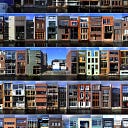Geometric considerations: Intensification vs extensification
What is the relative importance of a city being able to build up or out? Does geometry help us decide where to focus our attention?
I think some of the battle between car based automobile sprawl and multi-modal transport aided housing intensification is about geometry. Back when cities were small and built-up the invention and use of automobiles gave a huge one-off increase in developable land, competitive land supply then ensured houses were affordable.
Almost a hundred years later, some housing affordability advocates are still looking for that greenfield land-use ‘hit’. But the problem is that geometry of a growing city means the land immediately adjacent to the city grows linearly -there will be no additional exponential ‘hit’ of new land supply as big as that first hit (in proportion terms).
Further, the land inside the growing circle of a cities urban footprint becomes relatively larger compared to the land immediately adjacent to the city.
This means as cities grow, competitive housing markets become more about removing the restrictions on building up compared to those for building out. Both are important, but increasingly as cities grow they need to find ways to more efficiently allocate space internally and this is hard….
One way to look at the relative importance of building up versus out is to consider geometry. The argument goes like this;
The surface area in a circle is pi multiplied by radius squared.
The circumference of a circle is only pi multiplied by two times radius (diameter).
(The short answer to the teachers question is doubling the diameter only doubles the circumference but quadruples the surface area)
So as cities grow larger in diameter, the area within the circle of urbanised land is growing faster, than the area immediately adjacent to the circumference of the city -the rural/urban boundary.
Conceptually, cities have two urban growth boundaries -up or intensification and out or extensification. The intensification margin is determined by factors such as infrastructure provision and zoning laws regarding density, setbacks, shade planes, heritage, car parking minimums etc. While the extensification margin is again determined by infrastructure provision and zoning laws regarding greenfield growth.
So as cities get bigger the intensification margin becomes larger relative to the extensification margin.
Does this mean as cities get bigger, policies which could improve the efficiency of the intensification margin become relatively more important?
References:
Economics, Real estate & the supply of Land, Prof Alan W. Evans, 2004, Pages 32 to 38
